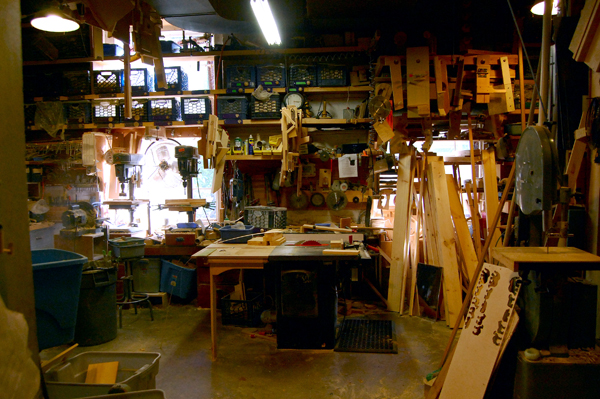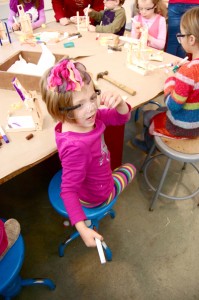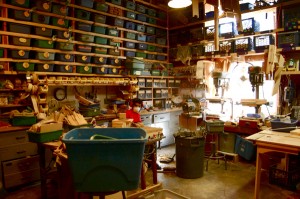
Bill Brown’s third-grade teacher once told him that if he didn’t learn to spell, he would be a truck driver. A few years later, another teacher threatened Brown with digging ditches for the rest of his life. Brown is now the director of the Eli Whitney Museum and Workshop. He speaks clearly and deliberately, and wears spectacles and an eye-patch over his right eye. “Well,” he smiles, “I own a truck, so I guess I am a truck driver. And I’ve given Yale volunteers ditches to dig before, and they don’t know what to do. A good ditch digger has a way of reading the soil, a kind of Zen focus on where to move rocks with a speed that takes your breath away.”
When Brown worked as a school social worker, he was often sent 9-year-old boys whose teachers wanted them “tamed.” But to Brown, their misbehavior was not the real problem. “Being the smartest kid in the school is the problem,” he says. “This is a fairly common paradox, where natural mechanics are told that they’re losers. They’ve never been told, ‘You are magical at this.’”
Through his work at the Eli Whitney Museum and Workshop, Brown tries to reach those with a different kind of intelligence, “people who see big pictures so intricate that English is inadequate” to describe them. Over the course of our conversation, he talks about accountants, religious mystics, dyslexics, and origami artists, saying, “They’re fascinated by intricacies, while other kids are caught up in the thematic lines of the Smurfs.” According to him, these are students who can’t sit still in a classroom, but become utterly absorbed by imagining esoteric mechanical processes.
Various treasures rest here and there in the museum staff offices: a set of wooden elephants, a metal acrobat held up by spindly limbs, other personal tokens from beloved students. There’s a large wooden worktable at the back and rows of plastic tubs filled with model boats and houses. They’re products of the museum’s workshop, which I visited on a Sunday in September when it was humming with activity. In uniforms of red t-shirts and safety goggles, high school-age apprentices sand surfaces and bore holes, cutting once and measuring twice. Amidst the sawdust and clamor, their seriousness of purpose and brisk competence, there are snatches of color: the red of their shirts, the aqua of a boy’s dyed hair, the wooden cat dolls being painted by a birthday party of younger children. The apprentices’ productivity is totally unlike the way I work as a Yale student. They are busy without being harried, focusing on their tasks with attention that isn’t scattered by multitasking. Everyone is utterly absorbed in their given duty.
The museum staff runs this apprenticeship program for students ages 13 through 18 in addition to offering workshops and visiting classrooms in schools. The apprentices, nicknamed “redshirts,” work at the museum for approximately five hours a week during the school year, and longer over summer vacations. In exchange, they receive a stipend and considerable training, and become involved in all of the museum’s operations. They master tools, assemble kits, and conduct workshops with visitors, eventually designing their own projects to add to the museum’s collection.

Brown and the museum staff constantly emphasize the importance of experimentation. They’re believers in the serious business of tinkering, and in the generative qualities of what most would call play. When they visit a classroom, it becomes a much more open space. However briefly, the work can present students with new and tangible challenges—challenges that occur in real time, with specific shapes and demonstrable consequences. This kind of challenge can only arise while working with your hands towards a particular goal: turning a wheel, igniting a spark.
…
The Eli Whitney Museum and Workshop collects “experiments.” Established in 1979, the red brick building on Whitney Avenue is located on the site of Eli Whitney’s historic factory in Hamden, which introduced mass production to the United States. Whitney was the first to give each worker a specific task in the manufacturing process. The image of his factory is well-known from history textbooks containing William Gyles Munson’s idyllic painting “The Eli Whitney Gun Factory.”
The museum outside the workshop is quieter. Here, exhibits are sectioned off in their own domain. A glassed-in model of the old factory stands silent. Waiting to be illuminated by the push of a button, miniature workers are frozen in their labor, each bending to his assigned task, forever striving towards their boss’s dream of uniform production.
The apprentices in the museum’s workshop, by contrast, are in constant motion. As Brown leads me on a tour he calls our “walking interview,” some of the teenagers stop us to ask him questions. They politely ignore my blank stares that betray an inability to visualize the dimensions they discuss, the screws and braces they name, and the difficulties they’ve encountered in building. They have developed a friendly but impenetrable jargon precisely for this space.
“I’ll be okay if we don’t finish the balancing circuses today,” Brown tells one student. “But we should finish the boats.”
Brown referred to two of the workshop’s projects. Where the workers of the old factory once built guns, the seven full-time staff and seventy-five apprentices now manufacture kits containing the materials for models and science experiments—seventy thousand a year. These kits are designed to teach science concepts to younger students, ranging from kindergarten to the eighth grade. The kits and the museum’s accompanying educational programs bring in approximately one million dollars annually, comprising 72 percent of the organization’s revenue. Other sources of income include the field trips that educators from the museum make to public and private schools in Connecticut and New York to conduct workshops in classrooms. The museum also earns money from visitors, usually families with young children, who assemble projects together on weekends or come in for birthday parties. Many attend the special programs held during school vacations, weaving scarves over winter break and designing tests for superhero-themed crash dummies over the summer. The rest of the museum’s revenue comes from First Factory products, projects sold wholesale to summer camps or local teachers.
These projects are the museum’s educational mission in a box. Designed to fulfill Connecticut standards for science curricula from kindergarten through eighth grade, each is intended to be easily completed in a classroom and to promote engagement with concepts through physical contact with materials. To learn about electricity, students build a basic circuit and battery pack, with the goal of lighting up a model house. To learn about energy and inertia, they build cars out of wooden wheels, rubber bands, and mousetraps.
Conducting these programs, the staff is dismayed by what they see as a lack of creative drive in today’s students. According to Sally Hill, the museum’s associate director and principal designer, teaching to the test has fostered a generation that constantly asks, “Is this okay? Is this right?”, often to the exclusion of more pressing questions. “They’re driven by a culture of ‘get it right, get an A,’ ” she says. “These are kids who take no risks.” These days, the museum’s educators no longer show “unelaborated models,” as Hill calls them, to classes. All examples are decorated, messed-with, or otherwise personalized beforehand. Unless they’re given this tacit license to explore, kids will churn out replicas utterly indistinguishable from the model, following directions and learning little.

Brown argues that it is more important today than ever before that students learn through mentorship. He was profoundly influenced by his mentor, Normand Method, a cabinet-maker and teacher who Brown says would try anything. Method instilled in Brown a passionate belief in learning’s “liberating function,” freeing doctors to become woodworkers, and making woodworkers realize that they can attend MIT seminars on electricity.
However, there is a dearth of mentorship in American classrooms today, Brown says, due in part to two things: schools which are pressed to meet state and federal benchmarks, and the monopoly that universities have on higher education. Universities dominate most young people’s visions of their future advancement even if they do not learn well in a traditional classroom. As a result, many have forgotten to stop to ask what they should be.
“The university system is not much different from the housing bubble.” Brown claims. “It’s a great mechanism to make people borrow money.” Though higher education is often valuable, he says, “It’s a suspicious product for the amount of money.”
Sara Thomas, an educator at the museum, agrees. An art teacher at a magnet school for eight years, she grew frustrated with a system that conveyed her students to colleges that they couldn’t afford. Wishing to be able simply to teach kids skills again, she joined the staff of the museum several weeks ago.
Brown and Thomas insist that there must be some way for young people to seek out meaningful learning experiences after high school, outside of two and four-year colleges: journeymen’s programs, for instance, or engineering internships. In our first email exchange, Brown asked, “You don’t get into Yale without a bookish predisposition. But what if you had wanted to be an electrician? Are there schools for deep thinking electricians? Are there schools that offer electricians a cultural/social experience equivalent to that part of your experience [at] Yale?” Is it possible, he asks, to have an Ivy League for auto mechanics?
This unique educational perspective is refreshing, but also somewhat alienating to visitors. The Eli Whitney staff members often refer to people as “outsiders,” though their tone is surprisingly free of judgment or suspicion. The usage seems protectively insular, as though the staff members feel they must defend their pursuit of an educational model that has been declared obsolete in America. Hill, catching herself using the word, explains, “It’s hard. We’re not typical in any way.” When pressed as to why, Karen Lenahan, the museum manager laughs, “Have you seen our office?”
According to Lenahan, the museum has adjusted to the recession by working harder to book programs at schools, though their contribution lines have remained steady. Such community loyalty has sustained this small organization despite a humble and unfashionable mission, and will continue to do so during times of fiscal hardship.

…
In fact, while businesses and nonprofits alike are trimming down wherever possible, the Eli Whitney Museum and Workshop has plans for growth. They have begun to raise funds for a $200,000 project: a 1,000-square foot expansion of the Design and Development Workshop to house a new computer numerical control robot alongside the one that was purchased three years ago. The CNC can scan a design to fabricate three-dimensional objects. The museum staff usually refers to it as “the Robot” in their pamphlets, or, conversationally, as “the Machine.”
Hill jokes that the museum divides its history into two periods, pre-Machine and post-Machine. Where an apprentice would once be tasked with drilling holes into hundreds of strips of wood, that job is now dispatched by the Machine with greater precision and speed. As a result, staple projects have been sharpened, made more beautiful, their constituent parts now fitting together more smoothly. The Machine also can produce prototypes practically on demand, enabling iterations of new projects that can be refined more quickly. More importantly, Hill says, it has expanded their sense of what is possible for their designs.
The specter of automation does not worry Hill. The Eli Whitney Museum and Workshop is far from eliminating the human element from their work, and even farther from devaluing the process of learning by doing. In order to design well with the robot, you first have to play with materials by hand. As apprentices advance, delegating tedious tasks can only improve their educational experience, allowing them to invest more time and energy in design and invention. To that effect, the museum has created the Norm Method Design Internship, a semester-long workshop intended to help the apprentices build a portfolio, a single concession to a world that demands résumés.
…
When Eli Whitney once said that his factory was producing armorers as well as arms, he meant it regretfully. His goal had been to phase out skilled labor in favor of simple, reproducible motions not subject to human variance. This industrial ethos, which used workers as interchangeable and replaceable bits, would not be fully developed until over a century after he established his firearms factory in 1798. Today, the museum that bears his name takes as its mission the continuation of the historical moment that Whitney was impatient to move beyond: when the energy of innovation and the zest of enterprise were balanced by production on a human scale, when there was dignity and craft in manufacturing. “We are not naïve,” reads the museum’s fund-raising literature. “We don’t forsee, or need, the steadily growing markets we enjoyed for the last ten years…We want to save—as only a computer can—the intricate and nuanced dimensions of our designs.”
Construction on the new building has already begun; as of mid-September, a space had been cleared, and in the intervening week between my visits, the first framed wall was erected. Gleaming with the paleness of new wood, the site resembled Munson’s landscape more closely today than ever before.
Photography: Tory Burnside-Clapp

